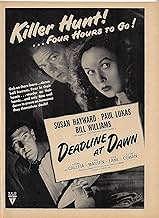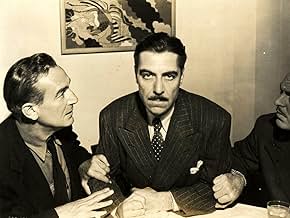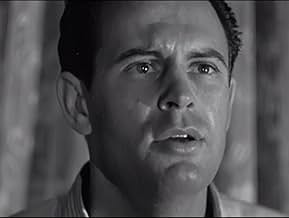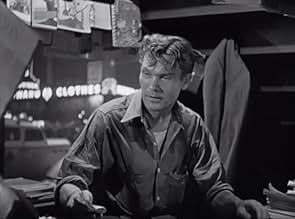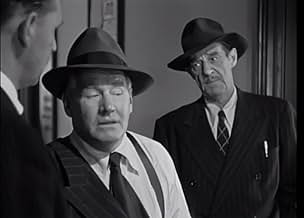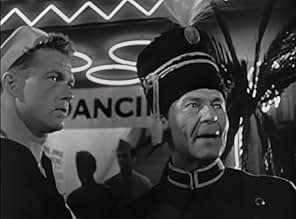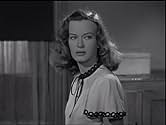PUNTUACIÓN EN IMDb
6,8/10
2,5 mil
TU PUNTUACIÓN
Añade un argumento en tu idiomaAfter a woman he meets is murdered, a soon-to-ship-out sailor has until dawn to find the killer, aided by a weary dance hall girl.After a woman he meets is murdered, a soon-to-ship-out sailor has until dawn to find the killer, aided by a weary dance hall girl.After a woman he meets is murdered, a soon-to-ship-out sailor has until dawn to find the killer, aided by a weary dance hall girl.
- Dirección
- Guión
- Reparto principal
- Premios
- 1 nominación en total
Ernie Adams
- Waiter
- (sin acreditar)
Fred Aldrich
- Beefy Nightclub Guest
- (sin acreditar)
Walter Bacon
- Commuter
- (sin acreditar)
John Barton
- One-Legged Man
- (sin acreditar)
Billy Bletcher
- Waiter
- (sin acreditar)
Reseñas destacadas
Little know post-WWII Film-Nior gem set in New York City on a hot sweltering summer night with one of the most unusual murder mysteries you'll ever see. The movie starts out with Sleepy Parsons, Marvin Miller, pleading with his estranged wife Edna, Lola Lane, for the $1,400.00 that she owes him. Edna after insulting the poor blind and very sick man Sleepy finds out that the money, Sleepy's $1,400.00, that she had in her purse is gone! what happened to it?
Earlier that evening Edna met this young sailor Alex, Bill Williams,on leave at a restaurant that her gangster brother Val Bartelli, Joseph Calleia, owned. After getting him drunk Val cheated him, playing cards, out of his pay. The story got even weirder when Edna telling Alex that she'll pay him to goes up to her place to fix her radio, Alex is a radio repairman in the navy, and got the poor slob even more drunk where he lost consciousness. waking up at a news stand after being given a cup of strong coffee by the newspaper man to clear his mind Alex staggered up on his feet a wad of $1,400.00 falls out of his pocket, where did it come from?
Going to a dance-hall later that night Alex gets very friendly with a local dance girl June, Susan Hayward. After June finished dancing with the costumers Alex goes with June to her place to have a bite to eat. At June's place Alex gets this bright idea to go back to where Edna lives and return the $1,400.00 ,which he feels is hers, with June coming along for the ride. When both get there they find, to their surprise and shock, that Edna was murdered, who did it? was it Alex? was it Sleepy? was it about a half dozen other suspects who had some connection with Edna? All I can say about the movie is that it will floor you with an ending that you won't see coming and even when it does! It will take you a while to realize what you missed in the clues that were so skillfully dropped leading to it all throughout the film.
"Deadline at Dawn" is one of those films that just sticks with you right from the start. Even though there's a number of flaws in it you easily overlook them when you realize that it's going in a direction that will more then make up for them, with it's almost unbelievable ending. Paul Lukas as NYC Cabbie, Gus Hoffman,is at first just an innocent bystander who picks up the couple, Alex & June.
As the movie goes on he becomes more and more central to the story by being more of a detective then a taxi driver as well as having the knowledge of a Ivy League Collage professor! whats this guy doing driving a cab? As the trio slowly work together time is running out to find out not only who murdered Edna but to also clear Alex of the crime, in which he's the prime suspect, and at the same time make it possible for Alex to catch the 6;00AM bus to Norfolk Virginia to report to his ship.
Powerful and surprising ending that has elements to it that you just rarely see in movies today and never in movies back then, in the 1940's. It really has you thinking about what is really good and bad in the world. Like I said before the ending just floored me not that it was so surprising, it was, but that it shows just how human and imperfect people are in the movie as well as they are in real life.
Earlier that evening Edna met this young sailor Alex, Bill Williams,on leave at a restaurant that her gangster brother Val Bartelli, Joseph Calleia, owned. After getting him drunk Val cheated him, playing cards, out of his pay. The story got even weirder when Edna telling Alex that she'll pay him to goes up to her place to fix her radio, Alex is a radio repairman in the navy, and got the poor slob even more drunk where he lost consciousness. waking up at a news stand after being given a cup of strong coffee by the newspaper man to clear his mind Alex staggered up on his feet a wad of $1,400.00 falls out of his pocket, where did it come from?
Going to a dance-hall later that night Alex gets very friendly with a local dance girl June, Susan Hayward. After June finished dancing with the costumers Alex goes with June to her place to have a bite to eat. At June's place Alex gets this bright idea to go back to where Edna lives and return the $1,400.00 ,which he feels is hers, with June coming along for the ride. When both get there they find, to their surprise and shock, that Edna was murdered, who did it? was it Alex? was it Sleepy? was it about a half dozen other suspects who had some connection with Edna? All I can say about the movie is that it will floor you with an ending that you won't see coming and even when it does! It will take you a while to realize what you missed in the clues that were so skillfully dropped leading to it all throughout the film.
"Deadline at Dawn" is one of those films that just sticks with you right from the start. Even though there's a number of flaws in it you easily overlook them when you realize that it's going in a direction that will more then make up for them, with it's almost unbelievable ending. Paul Lukas as NYC Cabbie, Gus Hoffman,is at first just an innocent bystander who picks up the couple, Alex & June.
As the movie goes on he becomes more and more central to the story by being more of a detective then a taxi driver as well as having the knowledge of a Ivy League Collage professor! whats this guy doing driving a cab? As the trio slowly work together time is running out to find out not only who murdered Edna but to also clear Alex of the crime, in which he's the prime suspect, and at the same time make it possible for Alex to catch the 6;00AM bus to Norfolk Virginia to report to his ship.
Powerful and surprising ending that has elements to it that you just rarely see in movies today and never in movies back then, in the 1940's. It really has you thinking about what is really good and bad in the world. Like I said before the ending just floored me not that it was so surprising, it was, but that it shows just how human and imperfect people are in the movie as well as they are in real life.
This modest film noir is flat-out crazy and a tremendous amount of fun.
Bill Williams plays a sailor on leave who follows a floozy back to her room, passes out and then finds upon waking that the floozy is dead and can't remember what if anything he had to do with it. He's got to catch a boat (or is it train?) at dawn, and is afraid he'll be implicated in the murder if he doesn't find the true killer before then. He teams up with a dance hall hostess (Susan Hayward) and, before the evening's out, a cab driver (Paul Lukas) and sets out into the New York midnight to solve the crime.
The screenplay doesn't make a lick of sense, and my wife and I found ourselves actually laughing at the preposterous developments and turns in the story. It's hilarious how committed these three people are to solving this crime despite the fact that there's absolutely nothing attaching the sailor to it, and how easy a time they have following up on clues in as huge a city as NY despite the fact that the clues are things like "he was wearing a tuxedo" and "she had blonde hair." A plot twist at the movie's end, when the real killer is revealed, is right up there with the best of them. Oscar winner Paul Lukas brings much more acting ability to his performance than his role requires, and Susan Hayward is absolutely riveting. This was my first and so far only exposure to this acclaimed actress, and I look forward to many more.
What a blast this movie is!
Grade: A-
Bill Williams plays a sailor on leave who follows a floozy back to her room, passes out and then finds upon waking that the floozy is dead and can't remember what if anything he had to do with it. He's got to catch a boat (or is it train?) at dawn, and is afraid he'll be implicated in the murder if he doesn't find the true killer before then. He teams up with a dance hall hostess (Susan Hayward) and, before the evening's out, a cab driver (Paul Lukas) and sets out into the New York midnight to solve the crime.
The screenplay doesn't make a lick of sense, and my wife and I found ourselves actually laughing at the preposterous developments and turns in the story. It's hilarious how committed these three people are to solving this crime despite the fact that there's absolutely nothing attaching the sailor to it, and how easy a time they have following up on clues in as huge a city as NY despite the fact that the clues are things like "he was wearing a tuxedo" and "she had blonde hair." A plot twist at the movie's end, when the real killer is revealed, is right up there with the best of them. Oscar winner Paul Lukas brings much more acting ability to his performance than his role requires, and Susan Hayward is absolutely riveting. This was my first and so far only exposure to this acclaimed actress, and I look forward to many more.
What a blast this movie is!
Grade: A-
Deadline at Dawn (1946)
If you can overcome, or overlook, the slightly stilted plot and the improbability of the events (in an O'Henry kind of way, if you know his clever short stories, though the actual writer is Clifford Odets, whose politics are not very visible), you'll be able to catch the really fine acting and directing here. And the nicely felt night crime drama that is really just a beautiful sappy love story (the best kind). The cast is small, the plot twists unreasonable but still enchanting, and the effect, in the end, is tightly wound.
While you might think the murder is the central premise (and it's key, for sure), or the sailor's blackout is the main event (and it isn't, really), you will eventually see it's the sailor himself, his utter innocence, that is both the core of the film and the driving force. This is the Odets part of the writing, character driven, and the sailor, through some effect of drinking we assume, has had a brief blackout, and he comes to his senses on the streets of New York with a lot of cash in his pocket. He's troubled, but we sympathize. Then a woman he was with is found dead. Still, this sailor is such the definition of innocence, there's no doubt--almost no doubt--that someone else did it. But who? And how can he defend himself?
Enter Susan Hayward, playing at first a kind of professional dance companion (the innocent side of prostitution, and a good match for our man). After work, she wants to help him because he's so clearly a good person, and then a cabbie strangely gets involved, too, sucked into the idea that justice will go wrong if the real killer can't be found. The dead woman had a couple of unsavory friends, and these two get into the plot in stages, and what we end up with is half a dozen clearly defined people all fighting for some small piece of personal clarity and internal well being.
It helps that all the actors are first rate small time contributors (Hayward is the one star, and is terrific). It also helps that the whole scenario is limited in time and space, so we get to feel like we are there, in New York, in this small neighborhood at night. It's great stuff on that level alone. The director? It's his one and only film. But the cinematographer was an old pro at the peak of his career, Nicholas Musuraca, who did a whole slew of noirs and dramas, some worth seeing just for the photography ("Spiral Staircase" comes to mind, but see the IMDb list). So whatever the small time credentials of much of the cast, there is some seriousness here that won't let go.
If the plot is a little preposterous, it's only because it's trying to package things too neatly. The writing is first rate, beyond plot structure, with some classic quotable lines that are either film noir staples or philosophical nuggets (the latter from the cabby, in particular). A film that would reward a second viewing just for the details of dialog and camera-work.
If you can overcome, or overlook, the slightly stilted plot and the improbability of the events (in an O'Henry kind of way, if you know his clever short stories, though the actual writer is Clifford Odets, whose politics are not very visible), you'll be able to catch the really fine acting and directing here. And the nicely felt night crime drama that is really just a beautiful sappy love story (the best kind). The cast is small, the plot twists unreasonable but still enchanting, and the effect, in the end, is tightly wound.
While you might think the murder is the central premise (and it's key, for sure), or the sailor's blackout is the main event (and it isn't, really), you will eventually see it's the sailor himself, his utter innocence, that is both the core of the film and the driving force. This is the Odets part of the writing, character driven, and the sailor, through some effect of drinking we assume, has had a brief blackout, and he comes to his senses on the streets of New York with a lot of cash in his pocket. He's troubled, but we sympathize. Then a woman he was with is found dead. Still, this sailor is such the definition of innocence, there's no doubt--almost no doubt--that someone else did it. But who? And how can he defend himself?
Enter Susan Hayward, playing at first a kind of professional dance companion (the innocent side of prostitution, and a good match for our man). After work, she wants to help him because he's so clearly a good person, and then a cabbie strangely gets involved, too, sucked into the idea that justice will go wrong if the real killer can't be found. The dead woman had a couple of unsavory friends, and these two get into the plot in stages, and what we end up with is half a dozen clearly defined people all fighting for some small piece of personal clarity and internal well being.
It helps that all the actors are first rate small time contributors (Hayward is the one star, and is terrific). It also helps that the whole scenario is limited in time and space, so we get to feel like we are there, in New York, in this small neighborhood at night. It's great stuff on that level alone. The director? It's his one and only film. But the cinematographer was an old pro at the peak of his career, Nicholas Musuraca, who did a whole slew of noirs and dramas, some worth seeing just for the photography ("Spiral Staircase" comes to mind, but see the IMDb list). So whatever the small time credentials of much of the cast, there is some seriousness here that won't let go.
If the plot is a little preposterous, it's only because it's trying to package things too neatly. The writing is first rate, beyond plot structure, with some classic quotable lines that are either film noir staples or philosophical nuggets (the latter from the cabby, in particular). A film that would reward a second viewing just for the details of dialog and camera-work.
The real star of this underappreciated noir is Clifford Odets' dialogue, which you either love or you hate. I love it. Really terrific performances, and even the bit players are memorable. Look for Group Theater vet Roman Bohnen in a tiny role as the building janitor with a dead cat-- "she could practically speak." Or Jerome Cowan, a B-movie actor in a zillion Forties flicks, wonderfully slimy as a Broadway producer. Filmed on a backlot, but it seethes New York more than most location movies.
Explosive lighting by cinematographer Nick Murasaca; a twisty, turning plot by mystery writer Cornell Woolrich; literate dialogue with heart from playwright Clifford Odets; and an estimable ensemble cast of fine character actors, plus a young, beautiful, and surprisingly effective Susan Hayward -- it all adds up to make this a little film noir gem.
It's a very New York piece, though it's also an example of RKO Pictures at its Hollywood best. And yet, for a film noir, there's a surprising sweetness, a current of innocence personified by the sailor boy accused of murder in a nocturnal urban jungle of violence, betrayal and corruption.
Highly recommended.
It's a very New York piece, though it's also an example of RKO Pictures at its Hollywood best. And yet, for a film noir, there's a surprising sweetness, a current of innocence personified by the sailor boy accused of murder in a nocturnal urban jungle of violence, betrayal and corruption.
Highly recommended.
¿Sabías que...?
- CuriosidadesJoe Sawyer's character of washed-up baseball player Babe Dooley was based on Chicago Cubs hitting great Hack Wilson whose alcoholism led to his steep professional and personal decline.
- PifiasAt the end, the main characters exit the 8th Police Precinct. It is night, and the streets are deserted. Yet when June and Alex drive away in the police car, it can be seen through the back window of the vehicle that the streets are bustling with activity, cars, and people, and it's bright and sunny.
- Citas
June Goffe: If you hear a peculiar noise, it's my skin creeping.
- ConexionesFeatured in Noir Alley: Deadline at Dawn (2017)
Selecciones populares
Inicia sesión para calificar y añadir a tu lista para recibir recomendaciones personalizadas
- How long is Deadline at Dawn?Con tecnología de Alexa
Detalles
- Fecha de lanzamiento
- País de origen
- Idiomas
- Títulos en diferentes países
- Un amanecer trágico
- Localizaciones del rodaje
- Backlot, 20th Century Fox Studios - 10201 Pico Blvd., Century City, Los Ángeles, California, Estados Unidos(New York night street scenes)
- Empresa productora
- Ver más compañías en los créditos en IMDbPro
- Duración1 hora 23 minutos
- Color
- Relación de aspecto
- 1.37 : 1
Contribuir a esta página
Sugerir un cambio o añadir el contenido que falta

Principal laguna de datos
By what name was Muerte al amanecer (1946) officially released in India in English?
Responde
